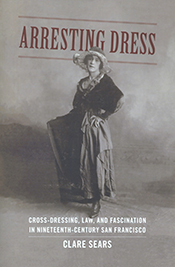When cross-dressing was criminal: Book documents history of longtime San Francisco law
In the early hours of a Sunday morning in December 1890, according to newspaper reports, Oscar Johnson was arrested on Kearny Street in San Francisco. The crime? Being clad in "a complete woman's outfit." When arrested, Johnson, who today would be accepted as a transgender woman, gave her name as Bettie Portel and was hit with the maximum sentence -- six months in jail.
 Many might be surprised to learn that in San Francisco, now recognized as a stronghold for LGBT rights, it was illegal to cross-dress in public for more than 100 years. In 1863, as part of a broad anti-indecency campaign, the city adopted a law that criminalized a person appearing in "dress not belonging to his or her sex."
Many might be surprised to learn that in San Francisco, now recognized as a stronghold for LGBT rights, it was illegal to cross-dress in public for more than 100 years. In 1863, as part of a broad anti-indecency campaign, the city adopted a law that criminalized a person appearing in "dress not belonging to his or her sex."
A new book, "Arresting Dress: Cross-Dressing, Law, and Fascination in Nineteenth-Century San Francisco," explores the stories behind this law, its significance and the culture it reflected and influenced. The work is the result of 10 years of research by Clare Sears, associate professor of sociology and sexuality studies at San Francisco State University.
San Francisco was not alone in the criminalization of non-normative gender expression, Sears explains. Between 1848 and 1900, 34 cities passed prohibitions against cross-dressing, followed by 11 more in the years leading up to World War I. San Francisco's law remained in effect until July 1974. Arrests were made as recently as May 1974, when 10 men were arrested in the Tenderloin for wearing women's clothing.

Associate Professor of Sociology and Sexuality Studies Clare Sears
According to Sears, the laws were typically passed in growing frontier towns seeking to attract middle-class families by cultivating a respectable image -- with the primary goal of cracking down on prostitution.
"At that time, a lot of cross-dressing practices were associated with prostitution," Sears explained. "For a woman to dress as a man in some way communicated to other people that she was more adventurous, more sexually available."
Police did not consistently enforce the laws. Women who casually dressed in drag for a night on the town, a popular fashion at the time, would typically not be prosecuted. But those whose behavior was deemed more problematic faced harsh consequences, including police harassment, public exposure, steep fines and jail time.
"It wasn't really about clothing," Sears said. "The laws were passed to police indecency and try to create a more sexually respectable city, and clothing was just a way to get to that."
The laws had a broader impact than might be expected. Sears describes one instance when a suspected male cross-dresser was taken into police custody and subjected to an invasive medical examination -- which revealed that she was, in fact, a woman. Police even sent her home with a certificate verifying her sex to help her avoid future arrests.
"The law made anybody who didn't quite fit into the narrow definitions of what a man or woman should look like have to be vigilant," Sears said.
In addition to chronicling injustices, "Arresting Dress" also includes inspirational stories of resistance and unflinching individuality. In the 1870s, for example, after having been arrested more than 20 times for wearing male attire, one woman said in court, "You may send me to jail as often as you please, but you can never make me wear women's clothing again."
Sears was deeply moved by the actions of people who remained true to themselves despite the consequences. "It blew me away that people were resisting and protesting in that way back then," she said. "Today we are aware of people collectively resisting these kinds of injustices, but back then, people were isolated from each other, individually standing up for themselves."
A sociologist, Sears initially had no intention of writing a history of 19th century laws. She stumbled upon information about the laws when researching ways that police targeted gay and lesbian communities and decided this little-known history needed to be shared.
"Transgender communities are becoming much more visible, and I think sometimes people think it's a new phenomena," Sears said. "Through these histories, we can learn that people have been dressing and living in a sex other than their legal one for a very long time -- and have been actively struggling for the right to do so. It's an important part of transgender history."
"Arresting Dress: Cross-Dressing, Law, and Fascination in Nineteenth-Century San Francisco" was published in December 2014 by Duke University Press.